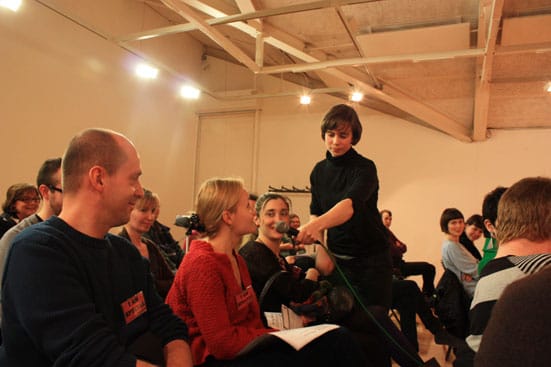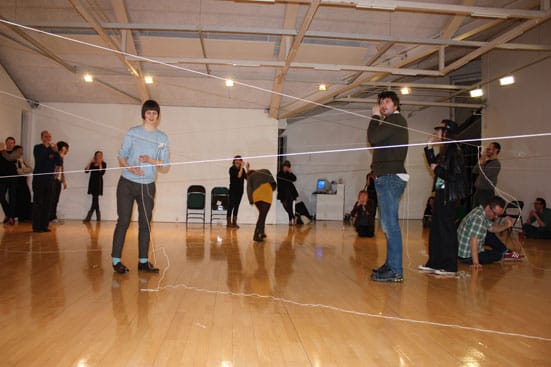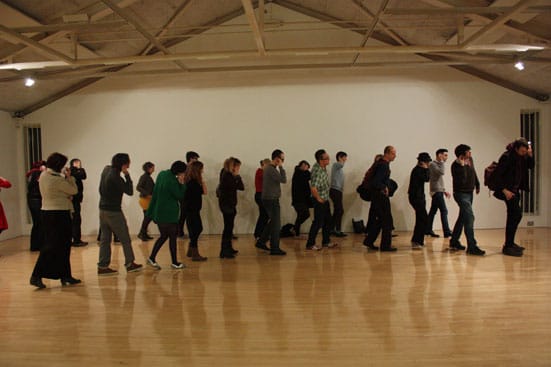With its myriad of multi–function, pseudo spaces, South Hill Park, was the location for the first event in Testing Grounds' 2011 programme, conceived around the concept of Failure. South Hill Parks' Outi Remes and William Trevelyan have created a uniquely facilitative context for experimental live performance to take place, drawing a truly eclectic audience. Amidst a back drop of adults dressed in scout uniforms, and milling theatre goers the audience was led to the ornate Haversham to view Kirstin Sherman & Natasha Rosling's LAM LAM IG POM.
Their dada title didn't disappoint. The pair transformed the panelled octagonal space with a series of squeaky, scratchy surfaces and squidgy sculptural forms. Six teenage girls wearing black, complete with gaffa tape faux protective headgear, also occupied the space.
As the girls begin to move, with heavy feet and vacuous expressions they manipulate the achingly tactile, cylindrical sculptures to make both shapes and non-shapes, coming together in an understated Hokey-Cokey formation using the sculptures to make delicate drawings within the space. As the nostalgic references to school and childhood pour in they are perfectly off-set with sinister tones such as the kitsch noose-like shapes leant against the walls.
LAM LAM IG POM was a beautiful portrait of adolescence, and a fair handed one too, full of both fairytale and unwelcome recollections of gym class. Their performers moved in Morse code and used their glib Vanessa Beecroftesque facial expressions to focus the audience on their synchronicities, executed with amateur perfection, neither under nor over-rehearsed, with neither mistakes nor beauty in their routine. The evocation of childhood devoid of nostalgia was an exquisite triumph. Timing, motion and movement formed a perfectly naive syntax on which the audience could project their own, personal flashbacks.
In the short performance the pair also touched on some of the heavyweight questions within live art. A carefully toed line of who was laughing at whom. Unsure if the performers were in on the joke or not, their perfect pregnant pauses allayed any doubts in the minds of the audience as to whether or not, they were in on the joke and furthermore that they were injecting their own irony on top of Rosling and Sherman's conception. There was a beautiful moment when Rosling stood at the back of the room watching intently as her performers glided over one another like dominos to collapse in a line. As she stared into the middle distance she appeared as one confronting six of her former selves, splayed out in the mirrored wall of a ballet class.
Rhythmic gymnastics, Michael Lehmann's Heathers, the Olympics, synchronised swimming, puberty, 60s sculpture, the British school system, Jacques Tati and Dali; the references were all there, broad and plentiful, bound in a seamless enigmatic portrait of a performance. Sherman and Rosling have created a fully immersive environment. Their world is composed of cherry picked aspects of daily life; the banal, the delicate and the downright ludicrous. They have crafted a visual language, which we can understand, but only they can speak; a master class in how to do things badly - well.
Next up, the conceptually vigorous, if deliberately unimaginatively entitled Failure. Sian Robinson Davies took the mic and rabbit-in-the-head lights style, declared that her collaborator Diego had not arrived and she didn't know what to do. Appealing to the audience, she began to muse on the possibility that he had done so deliberately as he was prone to be 'a bit dramatic sometimes'. Two minutes in and bam, half the audience are eating out of her hand, whilst the air was simultaneously tainted with latent hatred from the other half.
Luckily, (so the audience is led to believe) the performance had been previously scripted and an audience member duly volunteers to play the part of Diego, who turns out to be something of a comic genius, delivering the lines devoid of emotion of any kind.
At one point, Robinson Davies displays a knowing awareness of mounting audience tension, taking the mic to them to ask if they are finding the performance boring. This direct addressing of the audience along with her exaggerated passivity is a moment straight out of Michael Haneke's Funny Games. The audience's responses skirt the question of boredom, testifying to feelings of support and cynicism in equal measure.
Robinson Davies then proceeds with an Oscar worthy depiction of a kind of Zen damsel in distress, neatly framed as one of those good people that bad things happen to. And in an almost criminal helping of cuteness, the resulting saccharine sheen pulls the wool over even the most hardened cynic's eyes.
The audience duped, Robison and Chamy's tightly sewn up, heavily scripted piece runs wild. The script is a performative essay, a true manifestation of Searle's 1969 Speech Acts. Boredom is discussed to evoke Boredom. The words need to be performed, in order to have meaning. The head-spinning number of permutations of these meanings are played out and looped with a push and pull between the collaborators to make Becket proud. As Mac-clad twenty-something after Mac-clad twenty-something enters, proclaiming to be Diego, the penny drops that it's all a lie. There is no delayed flight, no kind audience members who stepped in, and no being thrown in at the deep end; the failure is an utter fabrication from start to finish.
The product of their work together is in many ways a re-contextualisation of one of Andy Warhol's deconstructions of 50's Hollywood. Ultimately Chamy and Robinson Davies have created a deconstruction of contemporary live art, and just like Warhol, it induces anger, embarrassment and respect in equal measure, and mass-man does not thank them for it. They do things badly, very well indeed.
Chamy and Robinson Davies' approach to failure evokes that of Soho's late Dandy, Sebastian Horsley. A man who contrived to be a living personification of failure – the ultimate fuck up, who even failed at the stunt he is most remembered for – his own crucifixion. Just as Chamy and Robinson Davies eloquently demonstrate, playing the loser makes you a winner. To proclaim yourself a failure prevents others from doing so, and this is the essence of their performance.
With more doppelgangers than the poster for Being John Malkovich, a script that makes Waiting for Godot look like a chat in a lift, Failure is an essay that can only have been a performance. Robinson Davies' Machiavellian delivery ensures that there are no failures here, only perfection. The audience inevitably ponders, 'Isn't this total shit?' and like Warhol, quizzed about the pornographic nature of his films, is told, 'Yeah... isn't it great?'
Lee Campbell's Lost for Words brought the evening to a close, utilising performance as a means of closure in itself. The audience re-enters after a short interval to find Campbell and his co-performer exquisitely framed in the space with an expanse of wooden floor and white walls behind them. They sit opposite one another on chairs in the stock academic student-lecturer set up.
Lost for Words takes its structure directly from academic process, the discussion of an idea, the resulting power struggle, the making of the work and the evaluation of the process. In true Campbell style this conservative structure makes for anything but a conservative performance.
Campbell and his student (Matthew) explore all the cringe-worthy power struggles that the roles of academia generate, but their delivery is like Educating Rita - on speed. Together the pair spin a soliloquy of cliché's, both beautiful and banal.
Campbell is all too familiar with the world of art academia, as both a lecturer and PhD student. The performance is heavily psychoanalytical, and though I would pay good money to see Campbell hauled up with his PhD supervisor in a shrink's office, Lost for Works provides a hearty slice of juicy voyeurism on that very scenario. In between the self-reflection and introspection of academia lies real Campbell gold. A few minutes in, he takes his audience on a rhythmic descent into a Dada boot camp. Before they know it audience members are circumnavigating the room with clear plastic cups pressed to their ears marching to Campbell's maniacal drum - all aboard space station Campbell.
There are several picture perfect moments when the two performers bound into the room in a dyspraxic nightmare, fusing binary opposites and corresponding actions. Left and right are heard as one succinct sound as the two gesticulate in contradicting directions. Campbell plays the peasant and the philosopher, and in beautiful Schrodinger's cat moments plays god, allowing multiple truths to exist in the same moment.
Lost for words is a performative articulation of Guy Debord's society of the spectacle. Reality is replaced by representation. Campbell seamlessly transfers theory into art, he creates visual articulations of tautologies, he teaches, and he teases. This piece has a library of theory behind it, but the real triumph of this work, continues to be Campbell's unharnessable and innate ability to direct his audience towards moments of cinematic perfection.
The audience find themselves 'connected' to a stranger up to 30 feet away with only a plastic cup and string as a means of communication and in this, the beautiful futility of human existence shines though; this is a magic moment.
Campbell is ultimately a painter who layers life. His pieces are portraits of humanity, where the good the bad and the ugly gel to make his audience nostalgic for now, where failure is celebrated and everyone exploited. Campbell is currently heavily focused on concepts of liminality, and this luminal state is exactly what he creates; neither a painting nor a performance, Lost for words is a work on canvas that combusts the very second it is complete.
The three performances, each approaching failure from different vantage points, together provide a vigorous articulation of issues in contemporary performance. The artists have each crafted pieces that are as equally relevant as research as they are as live events.
Collectively, the works survey themes of isolation vs. collectivity, shifts in pace, time and rhythm but most pertinently each demonstrates a heavy self-questioning and self-criticality.
Testing Grounds provides the space, time and money for artists to push their own boundaries, but what is ultimately satisfying is that any collaborative or individual struggles that may have taken place between the artists were not evident in the performances.
The time that Testing Grounds allows artists to develop their works clearly enables them to emerge from a process of dutiful thought and rehearsal having fused concept and research with their works, each able to transport the audience, and push their collective as well as individual practices in doing so.
Corinne Felgate

Kirstin Sherman & Natasha Rosling’s LAM LAM IG POM
Testing Grounds, South Hill Park

Kirstin Sherman & Natasha Rosling’s LAM LAM IG POM
Testing Grounds, South Hill Park

Sian Robinson Davies & Diego Chamy's Failure.
Testing Grounds, South Hill Park

Lost for Words by Lee Campbell
Testing Grounds, South Hill Park

Lost for Words by Lee Campbell
Testing Grounds, South Hill Park